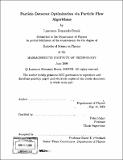| dc.contributor.advisor | Peter Fisher. | en_US |
| dc.contributor.author | Bronk, Lawrence Fernando | en_US |
| dc.contributor.other | Massachusetts Institute of Technology. Dept. of Physics. | en_US |
| dc.date.accessioned | 2009-01-30T16:49:39Z | |
| dc.date.available | 2009-01-30T16:49:39Z | |
| dc.date.copyright | 2008 | en_US |
| dc.date.issued | 2008 | en_US |
| dc.identifier.uri | http://hdl.handle.net/1721.1/44465 | |
| dc.description | Thesis (S.B.)--Massachusetts Institute of Technology, Dept. of Physics, 2008. | en_US |
| dc.description | Includes bibliographical references (p. 51). | en_US |
| dc.description.abstract | Using the the SLIC simulator software and the org.lcsim reconstruction framework package, the performance of Mat Charles' NonTrivialPfa.java PFA for several different detector variations was found by determining the mass resolution for a given detector geometry. The variations tested included the layering of the hadronic calorimeter, the radius of the calorimeter, the interaction material utilized in the hadronic calorimeter and the type of read-out used in the calorimeter. Based on the performance of the PFA for the different variations, the optimal detector specifications for use with the PFA were discovered. The optimal detector was found to use scintillator as the sensitive layer and steel as the interaction material in the hadronic calorimeter. A general trend in increased performance with more layering was also observed for the calorimeter. Also illuminated in the study was the discovery of unexpected performance for radius variations. | en_US |
| dc.description.statementofresponsibility | by Lawrence Fernando Bronk. | en_US |
| dc.format.extent | 51 p. | en_US |
| dc.language.iso | eng | en_US |
| dc.publisher | Massachusetts Institute of Technology | en_US |
| dc.rights | M.I.T. theses are protected by
copyright. They may be viewed from this source for any purpose, but
reproduction or distribution in any format is prohibited without written
permission. See provided URL for inquiries about permission. | en_US |
| dc.rights.uri | http://dspace.mit.edu/handle/1721.1/7582 | en_US |
| dc.subject | Physics. | en_US |
| dc.title | Particle detector optimization via particle flow algorithms | en_US |
| dc.type | Thesis | en_US |
| dc.description.degree | S.B. | en_US |
| dc.contributor.department | Massachusetts Institute of Technology. Department of Physics | |
| dc.identifier.oclc | 297176638 | en_US |
